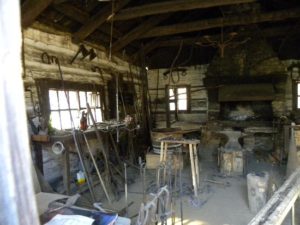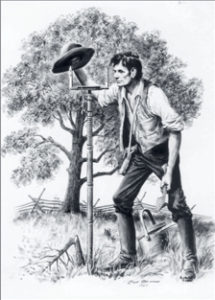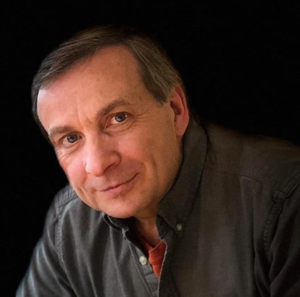 Abraham Lincoln briefly considered apprenticing as a blacksmith. Most subsistence farmers also doubled as tradesmen, working as coopers (barrel makers), tanners (leather makers), distillers (whiskey), brickmakers, shoemakers, or blacksmiths. While still in Indiana he and Dennis Hanks had spent many evenings in the Gentryville general store and at Baldwin’s blacksmith shop trading stories and “yarns,” so Lincoln had seen many an hour of blacksmithing in action.
Abraham Lincoln briefly considered apprenticing as a blacksmith. Most subsistence farmers also doubled as tradesmen, working as coopers (barrel makers), tanners (leather makers), distillers (whiskey), brickmakers, shoemakers, or blacksmiths. While still in Indiana he and Dennis Hanks had spent many evenings in the Gentryville general store and at Baldwin’s blacksmith shop trading stories and “yarns,” so Lincoln had seen many an hour of blacksmithing in action.
Blacksmiths were accorded an honored place in the village. They forged the plows, the tools, and the cookware needed to sustain life on the frontier. The village blacksmith was a “gunsmith, farrier, coppersmith, millwright, machinist, and surgeon general to all broken tools and implements,” one scholar put it. He could be called on to forge such a variety of implements as nails, horseshoes, chains, bullet molds, yoke rings, bear traps, bells, saws, and all the metal parts of looms, spinning wheels, and sausage grinders. Lincoln had been familiar with the cast iron plows he used when he was young. With its relatively high carbon content (over 2%), cast iron tends to be brittle, which caused problems for Lincoln back on the farm. On the other hand, iron could be cast into a variety of shapes using molds. As a blacksmith, Lincoln would have learned how to work with wrought iron, which has a very low carbon content (less than 0.08%) and much tougher, easy to hammer into useful shapes, could be drawn out into thin wires, corrosion resistant, and more easily welded.
Later, during the Civil War, Lincoln would recall his short-lived experience with blacksmithing to describe his relationship with George B. McClellan, the man he would assign as General-in-Chief of the Union Army but later described as “having the slows” because of his lack of aggressiveness in battle. Lincoln described a blacksmith in his boyhood days that tried to put to a purposeful use a big piece of wrought-iron he had in the shop. Firing up the forge, the blacksmith put the iron on the anvil determined to make a sledgehammer out of it. Giving up on that after a while, he decided to draw it out and make a clevis (a U-shaped fastener). After a few whacks and pumping the bellows to heighten the fire he again stopped. “Okay, maybe a bolt.” Working it hard for a while longer it now was too thin even for a bolt. Frustrated with his lack of success trying to make something useful happen, he proclaimed, “darn you, I’m going to make a fizzle of you.” And with that he dunked it into the water and let if fizz. McClellan, Lincoln told his friend, is someone who should have been productive but no amount of working him hard could make him useful. McClellan’s career soon fizzled out.
Being a blacksmith was respectable work, but it was also hard work, Lincoln decided. The idea of toiling over a hot forge, slinging a heavy hammer for hours on end while sweat poured from his skin was unappealing. Given his distaste for the hard labor of subsistence farming, Lincoln chose not to pursue blacksmithing. He would find some other trade.
[Adapted from Lincoln: The Fire of Genius]
David J. Kent is President of the Lincoln Group of DC and the author of Lincoln: The Fire of Genius, now available for pre-order on Amazon and Barnes and Noble (click on the respective links to pre-order). His previous books include Lincoln: The Man Who Saved America, Tesla: The Wizard of Electricity, Edison: The Inventor of the Modern World, and two specialty e-books: Nikola Tesla: Renewable Energy Ahead of Its Time and Abraham Lincoln and Nikola Tesla: Connected by Fate.
Check out my Goodreads author page. While you’re at it, “Like” my Facebook author page for more updates!



 The Sangamon County Deed Record on February 17, 1836 has this notation from Abraham Lincoln, the Surveyor.
The Sangamon County Deed Record on February 17, 1836 has this notation from Abraham Lincoln, the Surveyor. If you follow my Facebook page (
If you follow my Facebook page ( Louis Agassiz arrived at the White House on January 15, 1865 with Massachusetts Congressman Samuel Hooper. The famous scientist would have his one and only meeting with Abraham Lincoln. While the two influential men had never met before, Hooper was well-known to Lincoln. It was Hooper’s home in Washington DC that George McClellan had used as headquarters when he commanded the Union army. Hooper was also briefly the father-in-law of Charles Sumner, who had married Hooper’s daughter but divorced after only a short marriage. Today, however, the focus was on Agassiz.
Louis Agassiz arrived at the White House on January 15, 1865 with Massachusetts Congressman Samuel Hooper. The famous scientist would have his one and only meeting with Abraham Lincoln. While the two influential men had never met before, Hooper was well-known to Lincoln. It was Hooper’s home in Washington DC that George McClellan had used as headquarters when he commanded the Union army. Hooper was also briefly the father-in-law of Charles Sumner, who had married Hooper’s daughter but divorced after only a short marriage. Today, however, the focus was on Agassiz. Heck of a year, wasn’t it? I’m sure I’m not alone in admitting that the year in a writer’s life didn’t go exactly as planned. And yet, looking back on
Heck of a year, wasn’t it? I’m sure I’m not alone in admitting that the year in a writer’s life didn’t go exactly as planned. And yet, looking back on  Nancy Hanks Lincoln died October 5, 1818 of “the milk sick.” Or did she? While Abraham Lincoln biographers generally attribute her death to milk sickness, a possibility exists that it might have actually been something else. The story goes like this:
Nancy Hanks Lincoln died October 5, 1818 of “the milk sick.” Or did she? While Abraham Lincoln biographers generally attribute her death to milk sickness, a possibility exists that it might have actually been something else. The story goes like this: On June 30, 1862, the Senate confirmed Isaac Newton as Abraham Lincoln’s first Commissioner of the Department of Agriculture, which Lincoln had signed into existence a month earlier. Having come to despise the hard labor of his early years on subsistence farms, Lincoln had always favored government intervention to help people better their condition and looked for ways to bring science to agriculture.
On June 30, 1862, the Senate confirmed Isaac Newton as Abraham Lincoln’s first Commissioner of the Department of Agriculture, which Lincoln had signed into existence a month earlier. Having come to despise the hard labor of his early years on subsistence farms, Lincoln had always favored government intervention to help people better their condition and looked for ways to bring science to agriculture.






